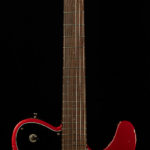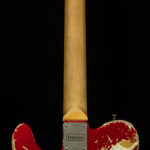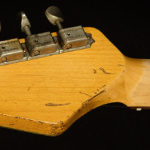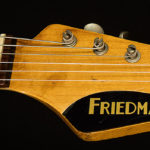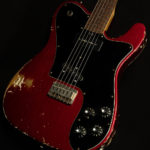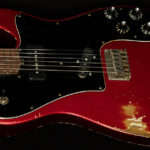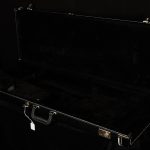Sheer Sonic Wizardry
For a long time, the guitar-playing community has wondered what makes Dave Friedman's amps sound so good, and now we get to ask ourselves the same questions about his guitars. How is he able to take wires, capacitors, and wood that you or I could buy at a hardware store and turn them into otherworldly rock and roll machines? For the longest time, I thought it was because he spent twenty years studying amplifiers in solitude like some sort of distortion-obsessed monk, and then applied his knowledge of every detail and nuance of amplifier design to every single amp that passed through his shop. Seems like a reasonable assumption to make, right?
So, when the latest batch of Friedman guitars arrived fresh from NAMM, I assumed that I would find guitars whose powers spring from Dave Friedman and Grover Jackson's PhD-level knowledge of every little thing that makes a guitar great. But as soon as I pulled one out of the case, it became apparent that I was terribly wrong, and that there was something much more sinister at work.
When I wrapped my hand around the neck, I realized that these guitars are filled with the same sort of ancient, arcane magic that Robert Johnson tapped into when he made his journey to the proverbial crossroads to learn how to play the blues. This is a bold claim to make, but Wildwood Guitars has never shied away from being bold. You heard it here first, folks:
Dave Friedman and Grover Jackson are clearly both warlocks with infinite magical powers, and they have figured out how to steal the souls of vintage guitars and transmute them into modern, hot-rodded axes.
I'm not sure how they do it (perhaps they have a soul-stealing assembly line set up in their shop), but I do know that guitar-makers with such eldritch, dark powers are not to be trifled with, and that we had better honor them by discussing what makes their instruments so good lest they become displeased with us and smite us with their terrible powers.
This is Not a Joke
It may seem ridiculous for me to claim that the incredible quality of these guitars is the result of supernatural soul thievery. Perhaps this is because they feel so thoroughly modern. They feature a compound 10-14” inch radius that makes it easy to play chords low on the neck and natural to shred on the higher frets. And, speaking of shredding, the Jescar frets are given a precise Plek setup that allows you to set the action ridiculously low and still have every note ring out clearly (the flatter radius helps with this, too!).
But the spectacular playability is only a red herring meant to distract us from the sinister magic that gives these guitars their tone. I assure you, this is not a claim I make lightly. But, after spending my day playing various Vintage Ts, it was the only reasonable explanation for the otherworldly mixture of modern clarity and vintage resonance that greeted my earholes when I plugged them in. Now, everyone claims that their guitars have "vintage vibe," and it is reasonable to regard such a claim with suspicion. But, I promise you that this is not an unqualified opinion.
You see, I grew up in Kalamazoo, Michigan, a town where everyone and their brother has a vintage guitar that they found in their uncle Frank's attic. Since I worked in music stores during my formative years, I got to play a disproportionate number of these attic classics, which gave me the opportunity to catalogue many of the sonic characteristics that make vintage guitars great. These Friedmans exhibit so many of these vintage traits that the only logical conclusion I can draw is that
Dave and Grover are mighty ageless sorcerers that have grown bored with toppling kingdoms and slaying demons and have instead taken to building incredible guitars.
They Stole Souls for Rock and Roll
For instance, many of my favorite vintage instruments have a particular kind of bass response that is very difficult to emulate. They sound deep and powerful, but they have a dry, woody resonance that places heavy emphasis on the fundamental. This allows the guitar to sound beefier than a steakhouse in Omaha while maintaining superior articulation and clarity!
Another big thing I've noticed during my travels in the vintage guitar world is that many of the finest old guitars have a touch-sensitive top-end with a wide dynamic range. By playing softly, you can get an open, airy sound with lots of high-end chime and quack. When you play hard, they scream, wail, bite and sizzle as if there is a tortured soul hiding in the pickup wire! By altering your attack slightly, you can reach every point in between these two extremes.
Finally, many of the best guitars from the sixties and seventies have a three-dimensional sound that is tough to quantify. The simple act of playing an open E chord causes you to become enveloped in sound as the notes bloom and create all sorts of overtones in the high register. Such full frequency response creates a sense of atmosphere and spaciousness that is endlessly inspirational!
It is nearly impossible to find all of these qualities in instruments made after the turn of the millennium, yet all of the Friedmans I've played have them in spades! Now, we could assume that this resonance comes from meticulous craftsmanship, quality wood, precisely Plek'd frets, and masterful pickup winding, but that's a silly explanation that only a small child would believe. If we use the scientific method like adults, the sound of these guitars is all we need to prove that
Grover Jackson and Dave Friedman have invented some sort of magical machine that rips the immortal souls out of old guitars and seals them within Friedman Vintage Ts for the rest of eternity.
Ghosts in the Machines
Now, obviously, the tone of this page is facetious. There is no soul-stealing assembly line in the Friedman Shop, and Grover and Dave are not wizards. They’re just builders who have mastered their craft so thoroughly that they might as well be magic. Regardless, I do believe that vintage guitars have certain inexplicable qualities to them that I call “ghosts.” Through their dedication to excellence, Grover and Dave really have figured out how to imbue new guitars with an old soul. Wildwood Guitars invites you to gaze upon their works of their hands and tremble at their awesome power.
[collapse]



